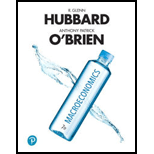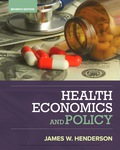
Macroeconomics (7th Edition)
7th Edition
ISBN: 9780134738314
Author: R. Glenn Hubbard, Anthony Patrick O'Brien
Publisher: PEARSON
expand_more
expand_more
format_list_bulleted
Concept explainers
Question
Chapter 5, Problem 5.3.1RQ
Subpart (a):
To determine
The definition of asymmetric information.
Subpart (b):
To determine
The definition of adverse selection.
Subpart (c):
To determine
The definition of moral hazard.
Subpart (d):
To determine
The definition of principal-agent problem.
Expert Solution & Answer
Want to see the full answer?
Check out a sample textbook solution
Students have asked these similar questions
please answer the following questions:
What is money, and why does anyone want it?
Explain the concept of the opportunity cost of holding money .
Explain why an increase in U.S. interest rates relative to UK interest rates would affect the U.S.-UK exchange rate.
Suppose that a person’s wealth is $50,000 and that her yearlyincome is $60,000. Also suppose that her money demand functionis given by Md = $Y10.35 - i2Derive the demand for bonds. Suppose the interest rate increases by 10 percentage points. What is the effect on her demand for bonds?b. What are the effects of an increase in income on her demand for money and her demand for bonds? Explain in words
Driving Quiz
X
My Course
G city place w
x
D2L Login - Univ
X
D2L Login - Univ x
D2L Login - U
acmillanlearning.com/ihub/assessment/f188d950-dd73-11e0-9572-0800200c9a66/4db68a5e-69bb-4767-8d6c-a12d
+1687 pts
/1800
© Macmillan Learning
Question 6 of 18
>
The graph shows the average total cost (ATC) curve, the
marginal cost (MC) curve, the average variable cost (AVC)
curve, and the marginal revenue (MR) curve (which is also
the market price) for a perfectly competitive firm that
produces terrible towels. Answer the three questions,
assuming that the firm is profit-maximizing and does not shut
down in the short run.
What is the firm's total revenue?
S
What is the firm's total cost?
$
What is the firm's profit? (Enter a negative number for a loss.)
$
Price
$320
$300
$200
$150
205 260
336
365
Quantity
MC
ATC
AVC
MR=P
1. Suppose that the two nations face the following benefits of pollution, B, and costs of
abatement, C: BN = 10, Bs = 7; CN = 5, Cs = 4. Further assume that if the nation chooses to
abate pollution, it still receives the benefits of pollution but now must pay the cost of
abatement as well.
a. Identify the payoffs that accrue to each nation under the four different possible
outcomes of the game and present these payoffs in the normal form of the game.
b. Recall that the term dominant strategy defines the condition that a player in a game
would prefer to play that strategy (in this case either pollute or abate) regardless of
the strategy chosen by the other player in the game. Does either nation have a
dominant strategy in this game? If so, what is it?
c. Identify the Nash equilibria, or non-cooperative equilibria, of this game.
Chapter 5 Solutions
Macroeconomics (7th Edition)
Ch. 5 - Prob. 5.1.1RQCh. 5 - Prob. 5.1.2RQCh. 5 - Prob. 5.1.3RQCh. 5 - Prob. 5.1.4PACh. 5 - Prob. 5.1.5PACh. 5 - Prob. 5.1.6PACh. 5 - Prob. 5.2.1RQCh. 5 - Prob. 5.2.2RQCh. 5 - Prob. 5.2.3RQCh. 5 - Prob. 5.2.4RQ
Ch. 5 - Prob. 5.2.5PACh. 5 - Prob. 5.2.6PACh. 5 - Prob. 5.2.7PACh. 5 - Prob. 5.2.8PACh. 5 - Prob. 5.2.9PACh. 5 - Prob. 5.3.1RQCh. 5 - Prob. 5.3.2RQCh. 5 - Prob. 5.3.3RQCh. 5 - Prob. 5.3.4RQCh. 5 - Prob. 5.3.5PACh. 5 - Prob. 5.3.6PACh. 5 - Prob. 5.3.7PACh. 5 - Prob. 5.3.8PACh. 5 - Prob. 5.3.9PACh. 5 - Prob. 5.3.10PACh. 5 - Prob. 5.3.11PACh. 5 - Prob. 5.3.12PACh. 5 - Prob. 5.3.13PACh. 5 - Prob. 5.3.14PACh. 5 - Prob. 5.3.15PACh. 5 - Prob. 5.4.1RQCh. 5 - Prob. 5.4.2RQCh. 5 - Prob. 5.4.3RQCh. 5 - Prob. 5.4.4RQCh. 5 - Prob. 5.4.5RQCh. 5 - Prob. 5.4.6PACh. 5 - Prob. 5.4.7PACh. 5 - Prob. 5.4.8PACh. 5 - Prob. 5.4.9PACh. 5 - Prob. 5.4.10PACh. 5 - Prob. 5.4.11PACh. 5 - Prob. 5.4.12PACh. 5 - Prob. 5.4.13PACh. 5 - Prob. 5.4.14PACh. 5 - Prob. 5.1CTE
Knowledge Booster
Learn more about
Need a deep-dive on the concept behind this application? Look no further. Learn more about this topic, economics and related others by exploring similar questions and additional content below.Similar questions
- agrody calming Inted 001 and me 2. A homeowner is concerned about the various air pollutants (e.g., benzene and methane) released in her house when she cooks with natural gas. She is considering replacing her gas oven and stove with an electric stove comprising an induction cooktop and convection oven. The new appliance costs $900 to purchase and install. Capping the old gas line costs an additional $150 (a one-time fee). The old line must be inspected for leaks each year after capping, at a cost of $35 for each inspection. a. If the homeowner plans to remain in the house for four more years and the discount rate is 4%, what is the minimum present value of the benefits that the homeowner would need to experience for this purchase to be justified based on its private net sub present value? b. While trying to understand how she might express the value of reduced exposure to indoor air pollutants in dollar terms, the homeowner consulted the EPA website and found estimates provided by…arrow_forwardAfter the ban is imposed, Joe’s firm switches to the more expensive biodegradable disposable cups. This increases the cost associated with each cup of coffee it produces. Which cost curve(s) will be impacted by the use of the more expensive biodegradable disposable cups? Why? Which cost curve(s) will not shift, and why not? Please use the table below to answer this question. For the second column (“Impacted? If so, how?”), please use one of the following three choices: No shift; Shifts up (i.e., increases: at nearly any given quantity, the cost goes up); or Shifts down (i.e., decreases: at nearly any given quantity, the cost goes down). $ Cost Curve Impacted? If so, how? Explanation of the Shift: Why or Why Not AFC No shift. Fix costs stay the same, regardless of quantity. Fixed cost is calculated as Fixed Cost/Quantity. Since fixed costs remain unchanged, AFC stays the same for each quantity. MC Shifts up. Since the biodegradable cups are more expensive, the…arrow_forwardStyrofoam is non-biodegradable and is not easily recyclable. Many cities and at least one state have enacted laws that ban the use of polystyrene containers. These locales understand that banning these containers will force many businesses to turn to other more expensive forms of packaging and cups, but argue the ban is environmentally important. Shane owns a firm with a conventional production function resulting in U-shaped ATC, AVC, and MC curves. Shane's business sells takeout food and drinks that are currently packaged in styrofoam containers and cups. Graph the short-run AFC0, AVC0, ATC0, and MC0 curves for Shane's firm before the ban on using styrofoam containers.arrow_forward
- PART II: Multipart Problems wood or solem of triflussd aidi 1. Assume that a society has a polluting industry comprising two firms, where the industry-level marginal abatement cost curve is given by: MAC = 24 - ()E and the marginal damage function is given by: MDF = 2E. What is the efficient level of emissions? b. What constant per-unit emissions tax could achieve the efficient emissions level? points) c. What is the net benefit to society of moving from the unregulated emissions level to the efficient level? In response to industry complaints about the costs of the tax, a cap-and-trade program is proposed. The marginal abatement cost curves for the two firms are given by: MAC=24-E and MAC2 = 24-2E2. d. How could a cap-and-trade program that achieves the same level of emissions as the tax be designed to reduce the costs of regulation to the two firms?arrow_forwardOnly #4 please, Use a graph please if needed to help provearrow_forwarda-carrow_forward
- For these questions, you must state "true," "false," or "uncertain" and argue your case (roughly 3 to 5 sentences). When appropriate, the use of graphs will make for stronger answers. Credit will depend entirely on the quality of your explanation. 1. If the industry facing regulation for its pollutant emissions has a lot of political capital, direct regulatory intervention will be more viable than an emissions tax to address this market failure. 2. A stated-preference method will provide a measure of the value of Komodo dragons that is more accurate than the value estimated through application of the travel cost model to visitation data for Komodo National Park in Indonesia. 3. A correlation between community demographics and the present location of polluting facilities is sufficient to claim a violation of distributive justice. olsvrc Q 4. When the damages from pollution are uncertain, a price-based mechanism is best equipped to manage the costs of the regulator's imperfect…arrow_forwardFor environmental economics, question number 2 only please-- thank you!arrow_forwardFor these questions, you must state "true," "false," or "uncertain" and argue your case (roughly 3 to 5 sentences). When appropriate, the use of graphs will make for stronger answers. Credit will depend entirely on the quality of your explanation. 1. If the industry facing regulation for its pollutant emissions has a lot of political capital, direct regulatory intervention will be more viable than an emissions tax to address this market failure. cullog iba linevoz ve bubivorearrow_forward
arrow_back_ios
SEE MORE QUESTIONS
arrow_forward_ios
Recommended textbooks for you

 Exploring EconomicsEconomicsISBN:9781544336329Author:Robert L. SextonPublisher:SAGE Publications, Inc
Exploring EconomicsEconomicsISBN:9781544336329Author:Robert L. SextonPublisher:SAGE Publications, Inc Economics (MindTap Course List)EconomicsISBN:9781337617383Author:Roger A. ArnoldPublisher:Cengage Learning
Economics (MindTap Course List)EconomicsISBN:9781337617383Author:Roger A. ArnoldPublisher:Cengage Learning
 Managerial Economics: A Problem Solving ApproachEconomicsISBN:9781337106665Author:Luke M. Froeb, Brian T. McCann, Michael R. Ward, Mike ShorPublisher:Cengage Learning
Managerial Economics: A Problem Solving ApproachEconomicsISBN:9781337106665Author:Luke M. Froeb, Brian T. McCann, Michael R. Ward, Mike ShorPublisher:Cengage Learning Principles of Economics 2eEconomicsISBN:9781947172364Author:Steven A. Greenlaw; David ShapiroPublisher:OpenStax
Principles of Economics 2eEconomicsISBN:9781947172364Author:Steven A. Greenlaw; David ShapiroPublisher:OpenStax


Exploring Economics
Economics
ISBN:9781544336329
Author:Robert L. Sexton
Publisher:SAGE Publications, Inc

Economics (MindTap Course List)
Economics
ISBN:9781337617383
Author:Roger A. Arnold
Publisher:Cengage Learning


Managerial Economics: A Problem Solving Approach
Economics
ISBN:9781337106665
Author:Luke M. Froeb, Brian T. McCann, Michael R. Ward, Mike Shor
Publisher:Cengage Learning

Principles of Economics 2e
Economics
ISBN:9781947172364
Author:Steven A. Greenlaw; David Shapiro
Publisher:OpenStax